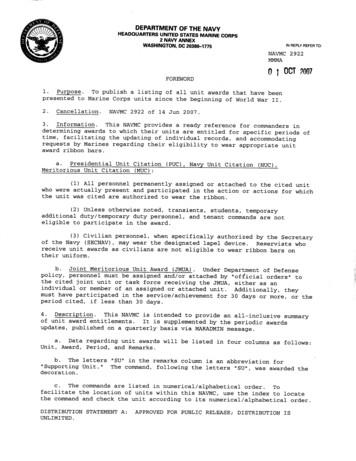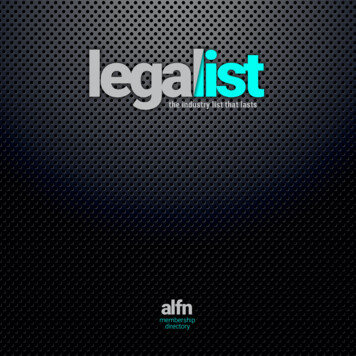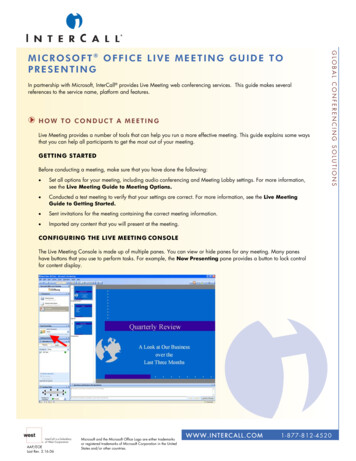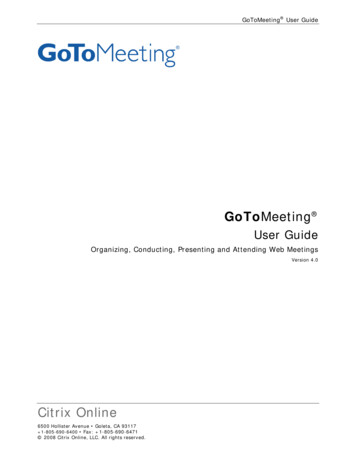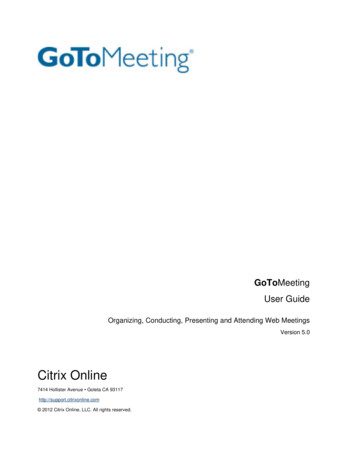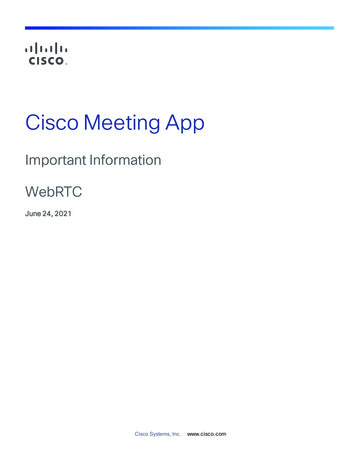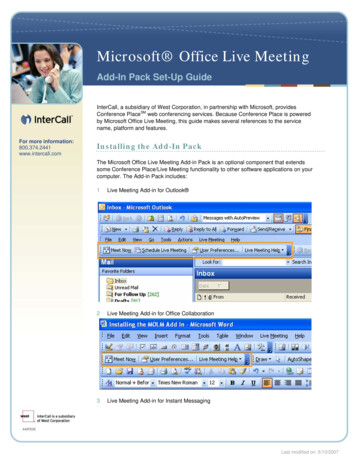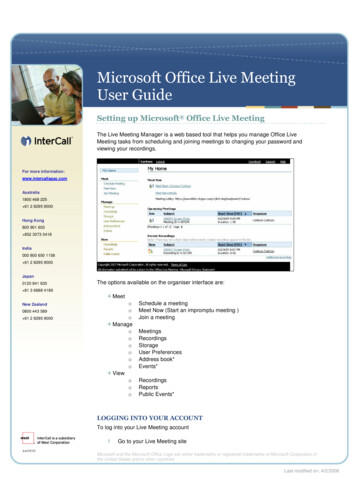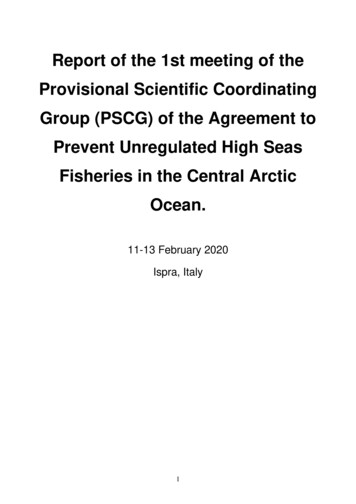
Transcription
Report of the 1st meeting of theProvisional Scientific CoordinatingGroup (PSCG) of the Agreement toPrevent Unregulated High SeasFisheries in the Central ArcticOcean.11-13 February 2020Ispra, Italy1
Executive summary . 3Introduction . 5ToR 01 – Rules of Procedures . 8ToR 02 – Incorporation of Indigenous and Local Knowledge (ILK) . 9ToR 03 – Update on the planned scientific activities . 12ToR 04 – Prioritize mapping activities . 15Ongoing activities in the CAO . 15Updates to knowledge gaps . 16Opportunities for data collection in the CAO . 16Proposal to establish a Fish Sampling Device Working Group . 18Identify priorities and assess implementation . 19List of meetings in 2020/21 where PSCG attendance would be useful . 22ToR 05 – Update inventory of monitoring programmes . 23List of participants . 41ANNEXES . 44Annex 01- Agenda . 45Annex 02 – Rules of Procedures for 1st Provisional Scientific Coordinating Group (PSCG,2020). 47Annex 03 – Proposal of Rules of Procedures future PSCG meetings or succeeding body49Annex 04 - Letter from the President of the Inuit Circumpolar Council (Alaska) . 53Annex 05 - Indigenous and Local Knowledge in the Greenland context . 552
Executive summaryThe Provisional Scientific Coordinating Group (PSCG) of the Preparatory Conference for theAgreement to Prevent Unregulated High Seas Fisheries in the Central Arctic Ocean, met for the firsttime from the 11th to the 13th of February 2020. The meeting was hosted by the European Union inthe European Commission Joint Research Centre facilities in Ispra, Italy. The PSCG was attended by37 experts from all signatories except China due to flight restrictions.The work carried out allowed the PSCG to address successfully the Terms of Reference (ToR) set bythe Meeting of Signatories of May 2019, and provide advice and relevant information to thePreparatory Conference for the Agreement, reflecting the best available scientific information.TOR 1 Develop Interim Rules of Procedure for the PSCGThe PSCG adopted interim rules of procedures for the current meeting and developed a proposal forfuture PSCG meetings, or succeeding body, to be submitted to the Preparatory Conference for theAgreement for their review and approval.TOR 2 Identify processes and mechanisms to incorporate indigenous and local knowledge,through the inclusion of representatives of Arctic communities, including Arctic indigenouspeoples, in the work of the PSCG, taking into account the outcomes of the workshop on this topicto be hosted by Canada.The PSCG suggests delegations for future PSCG meetings to include both scientists and otherexperts, including Indigenous and local knowledge holders, appointed by each Signatory as eachSignatory deems appropriate. The rules of procedures proposal (TOR 1) include options to allow thissituation. However, the PSCG observes the importance to ensure some level of continuity withineach PSCG delegation from meeting to meeting. Furthermore, the PSCG recognizes the largediversity across Indigenous and Local Knowledge holders’ communities and suggests thatapproaches to include Indigenous and local knowledge holders should be adjusted to each forum.The PSCG supports the continuation and fostering of the dialogue with Indigenous and localknowledge holders and suggests that mechanisms to foster such dialogue need to be considered andestablished, for example a PSCG working group. Lastly, PSCG participants decided to create acollection of literature related to this subject, which will be made available to all Signatories andtheir experts.3
TOR 3 Update the list in the 5th FiSCAO report1 of current or upcoming scientific activities andplatforms of opportunity for scientific mapping work in the Central Arctic Ocean that couldcontribute relevant information and data to the Joint Program of Scientific Research andMonitoring and identify the knowledge gaps addressed by each activity or platform.The PSCG updated information from the 5th FiSCAO report regarding current or upcoming relatedresearch programmes. Knowledge gaps covered by each activity were identified, as well as currentnational data sharing processes.TOR 4 Prioritize mapping work based on gaps identified in the 5th FiSCAO report, and anyupdates to these gaps, and coordinate among Signatories opportunities for conducting scientificmapping work in accordance with the Joint Program of Scientific Research and Monitoring,including by using upcoming scheduled scientific activities and platforms of opportunity identifiedby the Signatories.The PSCG identified priorities and a number of activities that constitute important opportunities tocollect information to support the mapping process. The PSCG suggests signatories and participantsto attend and present PSCG’s goals and results in future scientific meetings and workshops to raiseawareness of PSCG’s work and promote collaboration with other international and national bodies.The PSCG acknowledges that having several surveys collecting samples of fish in the Central ArcticOcean and adjacent areas may create a problem of comparability of results if the sampling devicesused are not standardized. Therefore, the PSCG proposes to the Signatories the creation of a workinggroup on the development and standardization of sampling devices to collect fish samples in theCentral Arctic Ocean and adjacent areas, to take place late 2020 or early 2021.TOR 5 Update the Inventory of Monitoring Programs in the High Seas Central Arctic Ocean andadjacent water (appendix B of 5th FiSCAO report)The list of Central Arctic Ocean monitoring programmes were updated by the signatories attendingthe PSCG.Following discussions with the chairperson of the Preparatory Conference for the Agreement, theKorean delegation announced its intent to host the next meeting of the Preparatory Conference forthe Agreement (dates and venue to be c fish stocks fifth meeting/pdfs/Final report of the 5th FiSCAO meeting.pdf4
IntroductionThe Signatories to the Agreement to Prevent Unregulated High Seas Fisheries in the Central ArcticOcean established a Provisional Scientific Coordinating Group (PSCG) to further prepare for theimplementation of the Agreement.The PSCG was established on an interim basis to provide scientific support and advice to theSignatories on matters related to the implementation of the Agreement, develop reports and advicefor the biennial Meetings of the Signatories2 (MoS), and provide support for the scientific workcalled for under the Agreement.In detail, the PSCG has the following objectives: Develop interim Rules of Procedure for the PSCG. Develop the Joint Program of Scientific Research and Monitoring (JPSRM), and, in theinterim, coordinate scientific activities by the Signatories in a manner consistent with Article4 of the Agreement. Develop the data sharing protocol as called for in Article 4 in the Agreement. Identify processes and mechanisms to incorporate indigenous and local knowledge, throughthe inclusion of representatives of Arctic communities, including Arctic indigenous peoples,in the work of the PSCG. Provide scientific advice for the development of conservation and management measures forexploratory fishing, and other interim measures, as requested by the Signatories. Develop quantitative indicators based, inter alia, on data collected during the mapping phase. Facilitate the possible exchange of samples. Promote cooperation by the scientific experts of the Signatories with relevant scientific andtechnical organizations, bodies, and programs. Other functions as may be assigned.The Provisional Scientific Coordinating Group (PSCG) of the Preparatory Conference for theAgreement to Prevent Unregulated High Seas Fisheries in the Central Arctic Ocean, met for the firsttime from the 11th to the 13th of February 2020. The meeting was hosted by the European Union atthe European Commission Joint Research Centre facilities in Ispra, Italy.2 or preparatory conference until MoS is set.5
The PSCG was attended by 37 participants from most Signatories as well as from the InternationalCouncil for the Exploration of the Sea (ICES) and the Northeast Atlantic Fisheries Commission(NEAFC). The Chinese delegation was not able to attend due to COVID19-related flight restrictions,and, due to scheduling conflicts, Indigenous and Local Knowledge holders were also unable toattend.The PSCG addressed the terms of reference set by the Meeting of Signatories of May 2019, and,with this report, provides advice and relevant information to the Preparatory Conference for theAgreement, reflecting the best available scientific information.The terms of reference given to the PSCG were: TOR 1 Develop Interim Rules of Procedure for the PSCG TOR 2 Identify processes and mechanisms to incorporate Indigenous and Local Knowledge,through the inclusion of representatives of Arctic communities, including Arctic indigenouspeoples, in the work of the PSCG, taking into account the outcomes of the workshop on thistopic to be hosted by Canada. TOR 3 Update the list in the 5th FiSCAO report3 of current or upcoming scientific activitiesand platforms of opportunity for scientific mapping work in the Central Arctic Ocean thatcould contribute relevant information and data to the Joint Program of Scientific Researchand Monitoring and identify the knowledge gaps addressed by each activity or platform. TOR 4 Prioritize mapping work based on gaps identified in the 5th FiSCAO report, and anyupdates to these gaps, and coordinate among Signatories opportunities for conductingscientific mapping work in accordance with the Joint Program of Scientific Research andMonitoring, including by using upcoming scheduled scientific activities and platforms ofopportunity identified by the Signatories. TOR 5 Update the Inventory of Monitoring Programs in the High Seas Central Arctic Oceanand adjacent water (appendix B of 5th FiSCAO report).Following discussions with the chairperson of the Preparatory Conference for the Agreement, theKorean delegation announced its intent to host the next meeting of the Preparatory Conference forthe Agreement. PSCG members expressed appreciation for the announcement, and the ticocean6
delegation undertook to provide further information about the meeting to Signatories, including datesand venue.7
ToR 01 – Rules of ProceduresA subgroup with representatives from all Signatories present discussed draft rules of procedure(RoP) for the present and future meetings of the PSCG, based on background documentationprovided by the chair. A note from the Chinese delegation concerning certain provisions of theproposed ToR was taken into account during the discussions. The group also benefitted from advicefrom experts from the International Council for the Exploration of the Sea (ICES) and the North EastAtlantic Fisheries Commission (NEAFC), as well as the Conference of Signatories’ chairperson.The RoPs adopted for the 1st meeting of the PSCG address decision-making, reporting, subgroups,transparency, and language (see Annex 02 – Rules of Procedures for 1st Provisional ScientificCoordinating Group (PSCG, 2020)).The recommendations for RoPs for subsequent meetings of the PSCG were discussed in severalsessions at the meeting (see Annex 03 – Proposal of Rules of Procedures future PSCG meetings orsucceeding body). The PSCG recommends that these interim RoP form the basis for future scientificmeetings once the Agreement enters into force. Regarding membership, the PSCG suggests holdersof Indigenous and Local Knowledge (ILK) be included among delegation’s experts, as eachSignatory deems appropriate. For procedural aspects of chairing meetings, the proposal includesdiscussions of the roles of both a chairperson and vice-chairperson and possible rotation ofchairpersons and timing aspects. Duties of the chairpersons are listed as well, including languagerelated to the invitation of external experts. With regards to the provision of advice andrecommendations, it’s suggested it should be by consensus, but, where agreement cannot be reached,the different views should be made explicit in the meeting report. The Order of Business sectionspecifies that documents have to be made available 20 days prior to any PSCG meeting. Regardingreporting, the PSCG suggests that written reports are prepared within certain time limits andsubmitted to Signatories before being made public. In addition, the proposal suggests rules on theestablishment of sub-groups and working groups, including their chairing, participation andreporting. The RoPs also includes language regarding participation in the PSCG by observers.8
ToR 02 – Incorporation of Indigenous and Local Knowledge (ILK)Through ToR 2, the Signatories charged the PSCG with identifying processes and mechanisms toincorporate Indigenous and Local Knowledge (ILK) in the work of the PSCG, taking into accountthe outcomes of the workshop on this topic hosted by Canada in Yellowknife, Northwest Territories,in November 2019. Unfortunately, due to scheduling conflicts no indigenous representatives wereable to attend the PSCG meeting. They could thus unfortunately not contribute actively to theconversation.Canada presented a summary of the discussions and outcomes from the Yellowknife workshop, andshared the three options discussed at the workshop: Option 1, PSCG membership would include delegations from each Signatory. Thosedelegations would include both scientists and ILK holders, as appropriate, sending productsand advice to the Signatories (i.e., decision-makers) as a single body. Option 2 would establish an Indigenous and Local Knowledge Working Group consisting ofrepresentatives of ILK holders, which would then provide information to the PSCG. PSCGdelegations would be designated in the same manner as described in Option 1. Jointlydeveloped products and advice would then be sent to the Signatories from the PSCG. Option 3 would establish two complimentary working groups: the PSCG and an ILKWorking Group. Under this option, the PSCG would consist of scientists, with ILK holders asobservers, and the ILK Working Group would consist of ILK holders with scientists asobservers. Each group would then provide independent products and advice to theSignatories.PSCG’s participants used the summary of these options as the starting point for discussions. It wasnoted that ILK and science are two complimentary knowledge systems. The Inuit CircumpolarCouncil considers Indigenous or Inuit Knowledge to be a “systematic way of thinking applied tophenomena across biological, physical, cultural, and spiritual systems. It includes insights based onevidence acquired through direct and long-term experiences and extensive and multigenerationalobservations, lessons, and skills. It has developed over millennia and is still developing in a livingprocess, including knowledge acquired today and in the future, and it is passed on from generation to9
generation4.” Thus, Indigenous Knowledge “goes beyond observations and ecological knowledge,offering a unique ‘way of knowing’ to identify and apply to research needs which will ultimatelyinform decision-makers5.”PSCG noted the importance of understanding how each Signatory works to incorporate and coproduce knowledge. Sharing these experiences is important for all Signatories (especially thosewithout indigenous communities) to understand, to help us establish successful processes andmechanisms to incorporate ILK into the PSCG and ultimately the Joint Program of ScientificResearch and Monitoring (JPSRM) called for in Article 4 of the Agreement.The PSCG participants recommend delegations for future PSCG meetings to include both scientistsand other experts, including ILK holders, appointed by each Signatory as they deem appropriate. ThePSCG would then establish working groups or sub-groups, as needed, with relevant expertiseincluded in each such group. Participants note this approach is reflected in the draft Rules ofProcedure developed under ToR 1. The PSCG also noted the diversity among indigenouscommunities throughout the Arctic. Indigenous and local representation on the PSCG should reflectthis diversity, while ensuring some level of continuity within each PSCG delegation from meeting tomeeting.In order to validate this approach, PSCG participants discussed presenting this proposed process to ameeting of Indigenous Knowledge holders currently proposed for June 2020 in Canada6.Complementary, it would also be helpful to discuss with the indigenous representatives, the objectiveof the Agreement and the key questions identified in the Fourth and Fifth FiSCAO reports, that needto be addressed by the mapping and monitoring phases. If considered relevant, the PSCGrecommends Signatories not involved in the June meeting should consider having a similar dialoguewith their ILK communities. Lastly, PSCG participants decided to create a collection of literature4Inuit Circumpolar Council-Alaska, Alaskan Inuit Food Security Conceptual Framework: How toAssess the Arctic From an Inuit Perspective. 2015, pp. 1–115.56IbidNote, due to the COVID-19 global pandemic, the proposed face-to-face workshop meeting inCambridge Bay, Nunvavut, was replaced with three online workshops. The first was held inearly July and the others will take place in the fall. The outcomes of the process remainunchanged.10
about the integration of ILK in the PSCG and JPSRM, which will be made available to allSignatories and their experts.A letter from the President of the Inuit Circumpolar Council (Alaska) expressing the views of theInuit Circumpolar Council (ICC) was circulated to all participants (see Annex 04 - Letter from thePresident of the Inuit Circumpolar Council (Alaska)). In annex 05 a description of Greenland’sapproach to deal with Indigenous and Local Knowledge is presented.11
.ToR 03 – Update on the planned scientific activitiesList of current and upcoming scientific activitiesToR 3 directed the PSCG to update the list of current and upcoming scientific activities in the HighSeas of the Central Arctic Ocean, firstly reported in the 5th FiSCAO report. The list was expanded toalso include relevant work in waters adjacent to the High Seas CAO. Participants identifiedupcoming scientific activities, platforms of opportunity, and added online registries of researchvessels and facilities to assist in identifying upcoming research opportunities (Table 1). In addition,participants also listed other expert groups conducting syntheses of information that includeecosystems in the High Seas CAO in their scope of work.Table 1 - Upcoming research vessels and programs collecting relevant data for the JPSRM in the High Seas CAO and inadjacent waters including the basic information on the data gaps addressed.Vessel or ProgramData GapKapitan Dranitsyn - RussianHydroacousticsUSA - Healey - heavy icebreaker.Hydroacoustics, oceanorgraphy, fishing might bepossible with a beam trawl via A-frame; Surfaceand Under-Ice Trawl (SUIT)USA – R/V SikuliagFishing capable, ice reinforced, could be charteredJOIS (SAS) - oceanographic - might add hydro acoustics?Hydroacoustics - likely no but might be able to beaddedWhales as data collection platforms.OceanographyCBS-MEA - if possible would they continue into the high seas?Fish, benthic invertebrates, zooplankton,oceanographyUSA – Presidential memorandum on Ocean mapping - map entire EEZ,specifically looking at shoreline of Alaska - graphic,can't combine multi-beam with fish hydroacousticsurveysSeabed 2030Oceanographic,can't combine multi-beam with fish hydroacousticsurveysNansen LegacyNot fishing - other programs are better for fishingCould they add some fishingNorway/Russia Barents Sea fish surveysHow far will this be extended into the high seasCAO?K-AOOS (Korea Arctic Ocean Observing System) - onboard IBRV AraonOceanographic and hydroacoustic surveys,ichthyoplankton sampling (no targeted fishsampling as yet)DBO vessels from any countryPAME shipping inventory12
Vessel or ProgramData GapEuropean Polar Board - catalogue and ce.euEU (Sweden) - OdenUpcoming expedition: SAS-Oden 2021, includingmesopelagic fish sampling under the CAO packice. Regular oceanographic expeditions in theArctic Ocean with focus on the CAO, operated bythe Swedish Polar Research Secretariat forscientific research.EU (Germany) - PolarsternRegular oceanographic expeditions in the CAO /availability of ship time via secondary userrequest: ndex 53 / fishingcapable (benthic, pelagic, Surface and Under-IceTrawl (SUIT) for ice-associated fauna - includingjuvenile polar cod)EU (Italy) - Laura BassyUpcoming expedition: SAS 2021Synoptic Arctic Survey (SAS) An initiative driven by scientists(https://synopticarcticsurvey.w.uib.no). Many of the vessels and projects belowparticipate in SAS in 2020-2022Synoptic Arctic Ocean ecosystem statusSynchronization of methodologyNABOS (USA, Russia, Germany)Oceanographic expeditions in CAO. Possibilityof hydroacoustics?Mirai (Japan)OceanographicList of other expert groups conducting work relevant to the PSCGThe PSCG recognizes that several expert groups are also conducting work relevant to understandfish dynamics and supporting ecosystems of the High Seas CAO and adjacent waters. To potentiallyavoid duplication of effort and to leverage existing activities, PSCG’s participants highlightedseveral of these groups and their activities: ICES/PICES/PAME Working Group for the Integrated Ecosystem Assessment of the CentralArctic Ocean (WGICA): This WG is developing integrated ecosystem assessments, includingecosystem overviews, for the Central Arctic Ocean using available information. Thegeographical scope includes the CAO Large Marine Ecosystem developed by PAME. CAFF’s Circumpolar Biodiversity Monitoring Program – Marine (CBMP-Marine): TheCBMP-Marine is a network of partners to harmonize and enhance long-term monitoringefforts on the status and trends of key marine species and their attributes. CBMP-Marine13
identifies eight Arctic Marine Regions, the High Seas CAO largely overlaps with the ArcticBasin but also other defined regions such as the Pacific-Arctic. Other Arctic Council working groups such as Protection of the Arctic Marine Environment(PAME) and Arctic Monitoring and Assessment Programme (AMAP): Potentially relevantprojects and assessments are undertaken by PAME and AMAP on themes related to climatechange, marine protected areas, ecosystem approach to management, shipping (underwaternoise, biological impacts) and pollution (marine litter). International Council for the Exploration of the Sea (ICES) and North Pacific Marine ScienceOrganization (PICES): Organizations that provide scientific coordination, data analysis,communications and advice. ICES, for example, provides advice to the North East AtlanticFisheries Commission (NEAFC) which includes under its jurisdiction a portion of the CentralArctic Ocean.14
ToR 04 – Prioritize mapping activitiesOngoing activities in the CAOThe Research Consortium EFICA (European Fisheries Inventory in the Central Arctic Ocean)presented ongoing field work in the High Seas of the CAO. The Consortium consists of scientificinstitutes from Sweden, Germany, Belgium, The Netherlands and Denmark, funded by the EuropeanUnion to collect primary data on fish stocks and ecosystem variables that currently live in the CAOduring 2019 and 2020. The field work has started through participation of EFICA scientists in theMOSAiC (Multidisciplinary drifting Observatory for the Study of Arctic Climate) expedition withthe German icebreaker Polarstern. This is a transpolar ice-drift expedition in the Amundsen andNansen Basins from 85o N outside the Laptev Sea (September 2019), over the North Pole area to ca.80o N in Fram Strait (October 2020). During the MOSAiC expedition, four methods are used for datacollection on fish stocks. However, the principal method normally used in fishery research, trawling,is impossible to employ because the ocean is covered by thick sea ice (usually 1-2 m).The first method is hydroacoustics for estimating stock size and structure of fish and zooplankton. Afull year of data will be obtained from MOSAiC during its passive drift with the sea ice. This will bea unique data set, because hydroacoustic data from vessels breaking ice cannot be used due to highnoise hindering the hydroacoustic record. During Leg 1 of MOSAiC, the EFICA scientists observedthe same mesopelagic deep scattering layer (DSL) in the Atlantic water layer as similar to apreviously observed DSL with the Swedish icebreaker Oden (2016), with similar very lowabundance of fish-sized organisms (size ca. 15 cm, 500 individuals km-2), which indicatesextremely low total stock biomass. The second method consists of visual observations with videocameras to validate echosounder data indicating fish versus large zooplankton, and potentially assessspecies and behaviour. During Leg 1 of MOSAiC, fish observations were extremely rare and the fishflee the camera lights too fast to be able to identify species. The rarity of fish observed confirms thelow biomass recorded by hydroacoustics. The third method comprises fish sampling from holes inthe ice with different fishing gears to assess species, diet, population genetics, and migration. DuringLeg 1 of MOSAiC, the EFICA scientists were able to sample four fish from the pelagic zone (data tobe published soon). This low number of fish sampled also confirms the low biomass recorded byhydroacoustics. Sympagic juvenile Boreogadus were often observed in holes and leads in the ice andwere systematically recorded by surveys with a ROV, but they were very difficult to catch and untilnow only two juvenile Boreogadus were sampled during MOSAiC Leg 1. The fourth and lastmethod is bioinformatics of eDNA as an indirect way to monitor the occurrence of fish and15
zooplankton by DNA sequences. For this purpose, weekly water samples are taken with Niskinbottles attached to a CTD during the whole MOSAiC year. EFICA scientists participate in theexpedition’s Core Parameter sampling, and will therefore have access to environmental and bioticdata crucial for interpreting the results.Updates to knowledge gapsSince the gap analysis in the Fifth FiSCAO Report (April 2018), the European Union has publishedthe Report “Review of the research knowledge and gaps on fish populations, fisheries and linkedecosystems in the Central Arctic Ocean (CAO)” cation/aae1e59e-46fe-11ea-b81b-01aa75ed71a1) in February 2020, which approaches the issuefrom a slightly different angle (more ecosystem-focussed). With respect to gap analysis on the CAOfish stocks, both reports arrived at similar conclusions. In spring 2020, another report is expected tobe published: the First Report of the ICES/PICES/PAME WGICA with the preliminary title“Integrated Ecosystem Assessment of the Central Arctic Ocean: Ecosystem description andvulnerability characterization”. The WGICA report concludes that the CAO is under-sampled andunderstudied when it comes to the fish fauna in this remote sea area. Based on these three reports, aswell as reports from previous FiSCAO meetings (2011–2017) and other scientific work, the PSCGsuggests an official start of the mapping phase of the JPSRM as soon as possible.Opportunities for data collection in the CAOAlthough scientific knowledge about the CAO and adjacent waters is increasing, it does notnecessarily refer to potential commercial fish species in the CAO. Expeditions to the CAO are veryexpensive, and the best way forward is to use opportunities of adding fish studies to already plannedscientific expeditions and routine monitoring programmes by the Signatories. In 2019-2021, severalexpeditions for collecting new primary data in the CAO are ongoing or will take place, e.g. theMOSAiC Expedition (see above), and the various expeditions within the Synoptic Arctic Survey(SAS). These scientific expeditions include programs for basic physical, chemical an
implementation of the Agreement. The PSCG was established on an interim basis to provide scientific support and advice to the Signatories on matters related to the implementation of the Agreement, develop reports and advice for the biennial Meetings of the Signatories 2 (MoS), and provide support for the scientific work called for under the .

